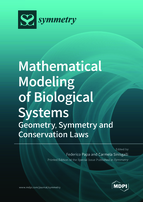Mathematical Modeling of Biological Systems: Geometry, Symmetry and Conservation Laws
A special issue of Symmetry (ISSN 2073-8994). This special issue belongs to the section "Life Sciences".
Deadline for manuscript submissions: closed (31 July 2021) | Viewed by 23521
Special Issue Editors
Interests: mathematical modeling of biological systems; mathematical modeling and control of tumor growth and treatment; mathematical modeling of epidemics; systems biology; dynamical system identification and filtering; optimal control theory
Special Issues, Collections and Topics in MDPI journals
Interests: mathematical and computational modeling in biology and medicine; mathematical oncology; signal and image analysis; dynamical system identification
Special Issue Information
Dear Colleagues,
Mathematical modeling is a powerful approach supporting the investigation of open problems in natural sciences, in particular physics, biology and medicine. Applied mathematics allows to translate the available information about real-world phenomena into mathematical objects and concepts. Mathematical models are useful descriptive tools that allow to gather the salient aspects of complex biological systems along with their fundamental governing laws, by elucidating the system behavior in time and space, also evidencing symmetry, or symmetry breaking, in geometry and morphology. Additionally, mathematical models are useful predictive tools able to reliably forecast the future system evolution or its response to specific inputs. More importantly, concerning biomedical systems, such models can even become prescriptive tools, allowing effective, sometimes optimal, intervention strategies for the treatment and control of pathological states to be planned.
The application of mathematical physics, nonlinear analysis, systems and control theory to the study of biological and medical systems results in the formulation of new challenging problems for the scientific community. This Special Issue is looking for innovative contributions of experienced researchers in the field of mathematical modelling applied to biology and medicine. Original research papers and reviews are welcome.Dr. Federico Papa
Dr. Carmela Sinisgalli
Guest Editors
“I know that in the study of material things number, order, and position are the threefold clue to exact knowledge: and that these three, in the mathematician’s hands furnish the first outlines for a sketch of the Universe.”
(D’Arcy Thompson, Growth and Form, 1917)
Manuscript Submission Information
Manuscripts should be submitted online at www.mdpi.com by registering and logging in to this website. Once you are registered, click here to go to the submission form. Manuscripts can be submitted until the deadline. All submissions that pass pre-check are peer-reviewed. Accepted papers will be published continuously in the journal (as soon as accepted) and will be listed together on the special issue website. Research articles, review articles as well as short communications are invited. For planned papers, a title and short abstract (about 100 words) can be sent to the Editorial Office for announcement on this website.
Submitted manuscripts should not have been published previously, nor be under consideration for publication elsewhere (except conference proceedings papers). All manuscripts are thoroughly refereed through a single-blind peer-review process. A guide for authors and other relevant information for submission of manuscripts is available on the Instructions for Authors page. Symmetry is an international peer-reviewed open access monthly journal published by MDPI.
Please visit the Instructions for Authors page before submitting a manuscript. The Article Processing Charge (APC) for publication in this open access journal is 2400 CHF (Swiss Francs). Submitted papers should be well formatted and use good English. Authors may use MDPI's English editing service prior to publication or during author revisions.
Keywords
- Mathematical Modelling of Biological Systems
- Mathematical Physics
- Symmetry/Asymmetry in Biological Patterns and Structures
- Computational Biology and Medicine
- Systems Biology
- Dynamical Systems
- System Identification and Filtering
- Optimal Control Theory
- Mathematical Oncology
- Epidemic Modelling
- Structured Population Models
- Biochemical Networks







